《英语》(基础模块)(修订版)第二册第七单元
- 格式:doc
- 大小:91.00 KB
- 文档页数:14
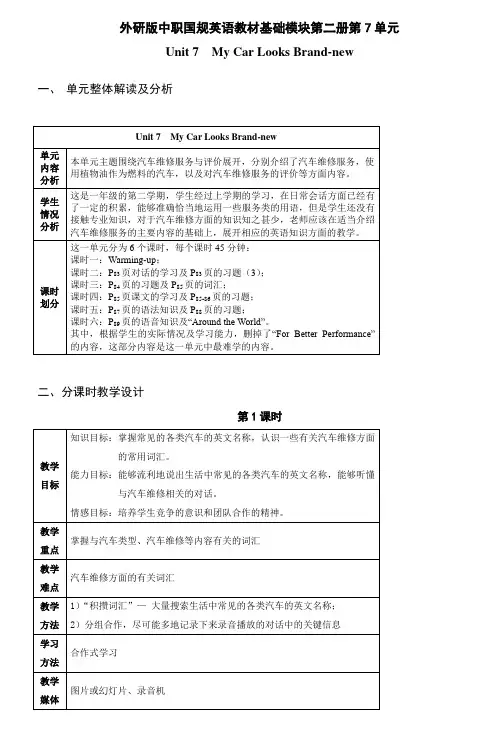
外研版中职国规英语教材基础模块第二册第7单元
Unit 7 My Car Looks Brand-new
一、单元整体解读及分析
二、分课时教学设计
第1课时
第2课时
第3课时
第4课时
第5课时
第6课时
作者简介
李艳,女,1981年12月生,湖北人,首都师范大学英语教育硕士,现就职于北京交通运输职业学院,英语讲师。
2005年,撰写《浅谈被动学习向主动学习的转化—发挥学生主动学习的能力》论文,获得北京市高职中专英语研究会二等奖;2008年,翻译《执行商》于中信出版社出版;2010年,参加外研社举办的中职英语课堂教学设计比赛,荣获一等奖。
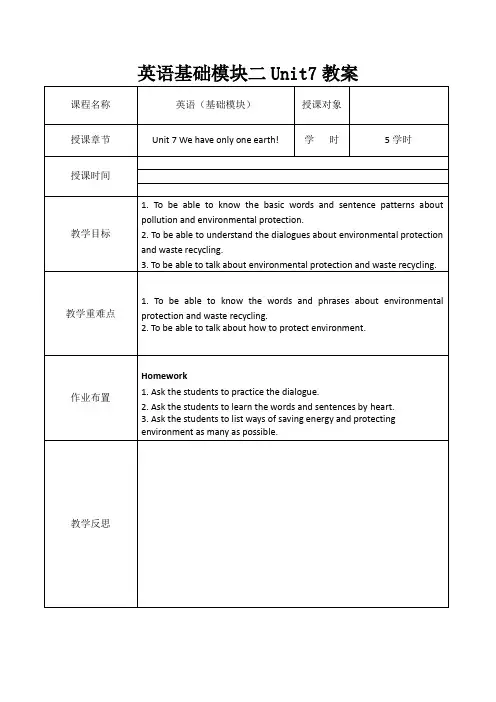
英语基础模块二Unit7教案S1: Happy new year, S2! Here’s a small gift for you.S2: Wow! What a beautiful toy rabbit! Is this a DIY gift?S1: Yes. I made it with an old glove.S2: It’s so charming/cute. And, it’s a great example of recycling, too.S1: I hope you like it.S2: Certainly. I like it very much. It’s really special. Thank you!Step 2 Listening & Speaking practice (2)H e Ying: Oh dear, look at the sky. It’s so dusty.Li Dong: How terrible! Another sandstorm is coming!He Ying: Yeah, it makes it hard for people to breathe.Li Dong: And the dust makes me feel very sick.He Ying: Me too. And look, the traffic is moving so slowly.Li Dong: Sandstorms may cause many traffic problems.He Ying: We must do something about it.Li Dong: Right. We should plant more trees and grasses.Listen again and fill. 7. Ask the students to listen to the dialogue again. And then ask them to make dialogues with the given words and pictures in Activity ③in pairs.1. Ask the students to look at the picture on Page 68 and guess what happened.2. Ask the students to listen to the dialogue of Activity ④and practice the dialogue after tape.3. Ask the students to repeat the dialogue and try translating it into Chinese.4. Present the two sentences and explain the different meanings:It makes it hard for people tobreathe.The dust makes me feel very sick.5. Listen and fill in the form in Activity ⑤.6. Ask the students to discuss other ways of preventing sandstorms. And make new dialogues about other kinds of pollution.1. Ask the students to read the ways of energy-saving and environment-protecting in Activity ①on Page 69, and pay attention to the words above.Step3:Reading Practice (1)I flush the toilet with grey water. And when I go shopping, I take a cloth bag or a basket.I ride my bike to school.I do paper folding crafts with old newspapers.When printing files, I use both sides of the paper.I use energy-saving light bulbs.Discuss and list.1. Turn off the lights when you leave the room.2.3.Key sentences:I flush the toilet with grey water.When printing files, I use both sides of the paper.Step4 Reading Practice (2)How can we fight against pollution at school?•Collect all waste paper and litter.•Never spit in public areas.•Take care of the plants on campus.•Volunteer to clean up the school.•Create a school website about environmental protection.•Put up educational posters around the school.•Put all rubbish in dustbins.•Organise a green club.Read and match. 2. Ask the students to listen to the tape, and answer the questions above.3. Play the tape again and ask the students to read after the tape. Explain the meanings of these sentences to the students.4. Ask the students to complete Activity ②.1. Ask the students to read the ways of fighting against pollution at school on Page 70, and learn the key words:2. Play the tape. Answer :How many measures does the passage mention? Do you spit in public areas?Do you have a green club in your school or class?3. Ask the students to listen to the tape again. Ask several students to state the ways of environment protecting in Chinese.4. Ask the students to look at the signs and pictures in Activity ④on Page 70, and then match them.1. Read the passage of Activity⑤, and answer the questions:How many categories can waste be classified into? What does recyclable rubbish include?Step 5 Reading Practice (3)Read and learn.Sorting refuse is a good way to save resources. In general, waste can be classified into four categories—recyclable rubbish, kitchen waste, harmful rubbish and other waste. Recyclable rubbish includes waste paper, plastic, glass, metal and cloth items. Kitchen waste usually includes leftovers, bones, vegetable roots, leaves, peel, etc. Harmful rubbish includes used batteries, broken lamps, expired drugs, etc. Other waste usually consists of things that are difficult to recycle, such as bricks, toilet paper, tissues, etc.Read again and classify【课堂小结】Step 6 Consolidation and summaryI. Review the words in this lesson.II. Pick up some sentences from this unit and put them on the slide. Ask the students to explain and translate them.III. Encourage the students to save energy and protect environment in daily life.【板书设计】What does kitchen waste usually include?What does harmful rubbish include?2. Present the new words:sort refuse resource in general classify waste category3. Ask the students to listen to the tape and pay attention to the words.4. Play the tape again. Listen and try to classify the four kinds of rubbish in Activity ⑤.5. Read the passage again, and complete the exercise in Activity ⑥.6. Check the answers and learn the words together.。
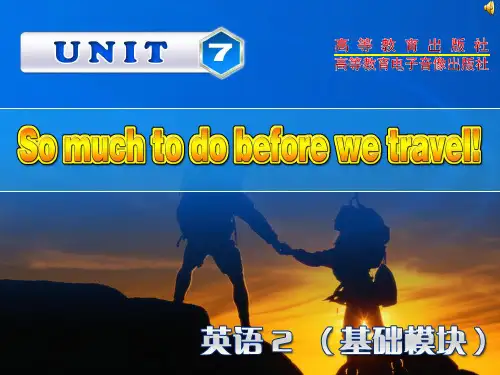
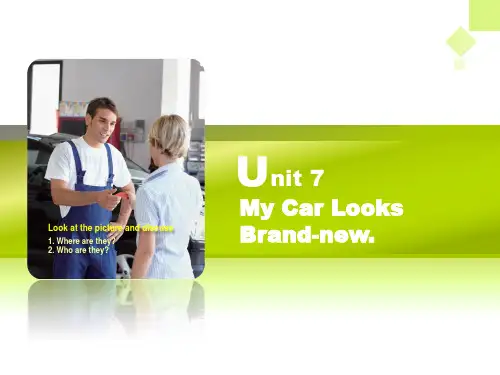

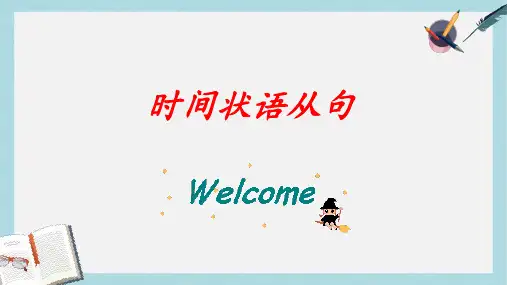
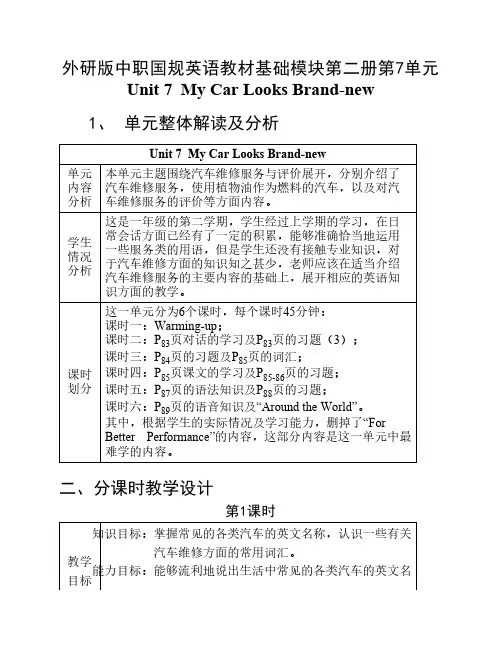

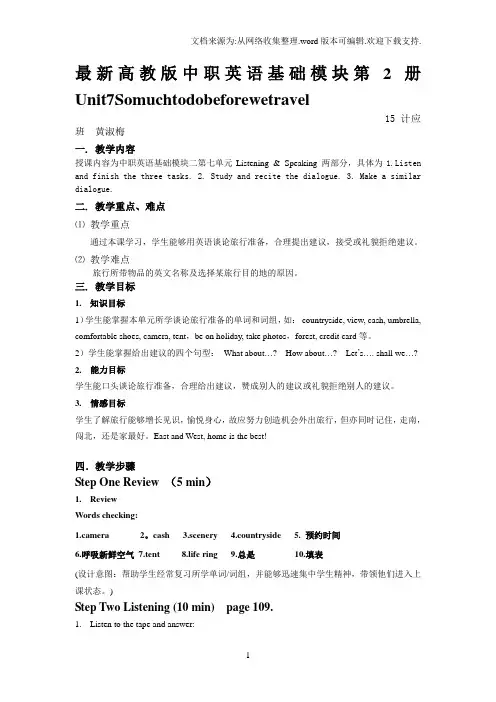
最新高教版中职英语基础模块第2册Unit7Somuchtodobeforewetravel15计应班黄淑梅一. 教学内容授课内容为中职英语基础模块二第七单元Listening & Speaking 两部分,具体为1.Listen and finish the three tasks. 2. Study and recite the dialogue. 3. Make a similar dialogue.二. 教学重点、难点⑴ 教学重点通过本课学习,学生能够用英语谈论旅行准备,合理提出建议,接受或礼貌拒绝建议。
⑵ 教学难点旅行所带物品的英文名称及选择某旅行目的地的原因。
三. 教学目标1.知识目标1)学生能掌握本单元所学谈论旅行准备的单词和词组,如:countryside, view, cash, umbrella,comfortable shoes, camera, tent,be on holiday, take photos,forest, credit card等。
2)学生能掌握给出建议的四个句型:What about…? How about…? Let’s…. shall we…?2. 能力目标学生能口头谈论旅行准备,合理给出建议,赞成别人的建议或礼貌拒绝别人的建议。
3. 情感目标学生了解旅行能够增长见识,愉悦身心,故应努力创造机会外出旅行,但亦同时记住,走南,闯北,还是家最好。
East and West, home is the best!四.教学步骤Step One Review (5 min)1.ReviewWords checking:1.camera 2。
cash 3.scenery 4.countryside 5. 预约时间6.呼吸新鲜空气7.tent8.life ring9.总是10.填表(设计意图:帮助学生经常复习所学单词/词组,并能够迅速集中学生精神,带领他们进入上课状态。
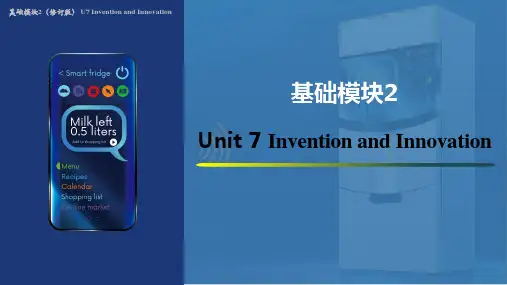
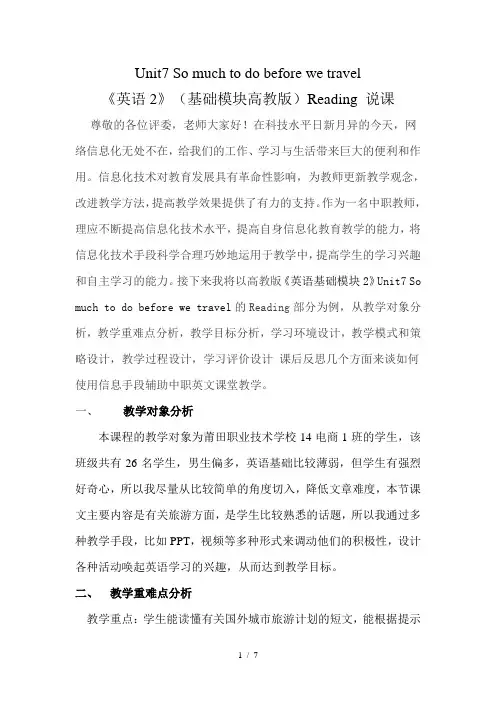
Unit7 So much to do before we travel《英语2》(基础模块高教版)Reading 说课尊敬的各位评委,老师大家好!在科技水平日新月异的今天,网络信息化无处不在,给我们的工作、学习与生活带来巨大的便利和作用。
信息化技术对教育发展具有革命性影响,为教师更新教学观念,改进教学方法,提高教学效果提供了有力的支持。
作为一名中职教师,理应不断提高信息化技术水平,提高自身信息化教育教学的能力,将信息化技术手段科学合理巧妙地运用于教学中,提高学生的学习兴趣和自主学习的能力。
接下来我将以高教版《英语基础模块2》Unit7 So much to do before we travel的Reading部分为例,从教学对象分析,教学重难点分析,教学目标分析,学习环境设计,教学模式和策略设计,教学过程设计,学习评价设计课后反思几个方面来谈如何使用信息手段辅助中职英文课堂教学。
一、教学对象分析本课程的教学对象为莆田职业技术学校14电商1班的学生,该班级共有26名学生,男生偏多,英语基础比较薄弱,但学生有强烈好奇心,所以我尽量从比较简单的角度切入,降低文章难度,本节课文主要内容是有关旅游方面,是学生比较熟悉的话题,所以我通过多种教学手段,比如PPT,视频等多种形式来调动他们的积极性,设计各种活动唤起英语学习的兴趣,从而达到教学目标。
二、教学重难点分析教学重点:学生能读懂有关国外城市旅游计划的短文,能根据提示信息写出北京一日游的计划书。
教学难点:学生能够运用所学的语言知识写出最佳旅行小手册。
三、教学目标分析1、知识目标(1)学生能掌握下列单词的用法:excellent, fresh, show, opera, entire, wish, get close to(2)学生能掌握下列词组的用法:a two-day tour plan millions of + n(s) / 数词+million +n(s)2、能力目标(1)学生能读懂有关国外城市旅游计划的短文。
Book1 Unit 7 So much to do before we travel. 1课时15计应班黄淑梅一. 教学内容授课内容为中职英语基础模块二第七单元Listening & Speaking 两部分,具体为1.Listen and finish the three tasks. 2. Study and recite the dialogue. 3. Make a similar dialogue.二. 教学重点、难点⑴ 教学重点通过本课学习,学生能够用英语谈论旅行准备,合理提出建议,接受或礼貌拒绝建议。
⑵ 教学难点旅行所带物品的英文名称及选择某旅行目的地的原因。
三. 教学目标1.知识目标1)学生能掌握本单元所学谈论旅行准备的单词和词组,如:countryside, view, cash, umbrella,comfortable shoes, camera, tent,be on holiday, take photos,forest, credit card等。
2)学生能掌握给出建议的四个句型:What about…? How about…? Let’s…. shall we…?2. 能力目标学生能口头谈论旅行准备,合理给出建议,赞成别人的建议或礼貌拒绝别人的建议。
3. 情感目标学生了解旅行能够增长见识,愉悦身心,故应努力创造机会外出旅行,但亦同时记住,走南,闯北,还是家最好。
East and West, home is the best!四.教学步骤Step One Review (5 min)1.ReviewWords checking:1.camera 2。
cash 3.scenery 4.countryside 5. 预约时间6.呼吸新鲜空气7.tent8.life ring9.总是10.填表(设计意图:帮助学生经常复习所学单词/词组,并能够迅速集中学生精神,带领他们进入上课状态。
UNIT 7 SO MUCH TO DO BEFORE WE TRAVEL沈利琼东钱湖旅游学校一、学情分析我授课的对象为旅游专业学生,而且女生占大多数。
她们热情、好动、中文语言表达能力强,还不怕羞。
但是学生的英语综合能力较差,词汇量小,口语表达不流利,语法基础差,书写困难,而且学生的综合能力参差不齐。
针对她们的这种情况,我设计了不同难度的教学步骤,以适应各种程度的学生。
并尝试降低教材难度,鼓励学生通过合作学习解决任务。
二、教材分析1.教学内容本课选自英语2(基础模块)第七单元So much to do before we travel的读写部分—Two- day tour in Sydney. 本单元的话题是旅游, 这个主题贴近学生的生活而且有实效性,能学而用之。
本节课是关于悉尼二日游的旅行计划,里面包含许多悉尼景点的词汇,学生在认知和运用方面有困难。
在写作部分,教师将以宁波本土的景点取代北京的景点。
2.教学重点、难点基于教学目标和教材分析,确立本课的重点为整体理解阅读内容和掌握旅行计划的制定。
难点为引导学生掌握悉尼景点的正确读法以及如何开拓学生的思维,学以致用。
3.教学方法本课以“教师为主导,学生为主体,训练为主线”的教学方针,主要采用了头脑风暴法、讨论法、情景创设法等教学方法。
教师引导学生在学习过程中通过个人活动、小组活动和整体活动等不同的活动形式一步步完成老师布置的任务,充分参与到教学活动中来,做学习的主人。
为了提高学生参与活动的积极性,增强竞争,把班级分成三个小组,累计得分。
三、教学目标1.知识目标1)学生能够掌握悉尼二日游旅行计划中出现的景点名称。
2)学生能够掌握旅行计划的基本组成。
2. 能力目标1)学生能够看懂旅行计划。
2)学生能够写出旅行计划。
3. 情感目标1)学生能够提高参与、合作和竞争意识。
2)学生能够更加热爱自己的家乡、热爱自己的专业。
四、教学步骤感谢您的阅读,祝您生活愉快。
Unit 7 We need to make some preparations before wetravel.(第二课时教学设计)一、教材分析1.教学内容本课时系教材《英语基础教程》(2)第七单元的第二课时,包括Reading and writing 部分,具体内容为:能读懂关于以旅行攻略为主题的文章;能书写简单的旅行日程安排和游览活动;同时掌握基本的外出旅行常识,树立正确的世界观,了解多元文化,热爱生活,提升国际意识。
2.教学重点、难点⑴教学重点掌握重点词汇和短语;学生能通过阅读,读懂普吉岛旅行的日程安排和相关活动,提高获取相关大意和细节信息的能力;培养学生阅读并整合信息的能力,而且能读以致用,通过阅读能能书写简单的旅行日程安排和游览活动的小短文。
⑵教学难点灵活正确使用重点词汇和短语;能根据关键句型写出简单的旅行日程安排和游览活动的小文段。
二、教学目标1.知识目标⑴理解并掌握关于旅行的相关词汇,如:backpacker, share, experience, post, recommend, blog, drift, view, excitement, coral, yachting, massage, bargain, tip, appreciate, spicy, luggage , be famous for, go snorkeling⑵掌握描述旅行活动的句型,如:You may start the day with...It is famous for...You’ll enjoy beautiful views as well as the excitement of...You can spend half a day on...You can go snorkeling and experience the fun of ...Since you are in ..., ... is a must-try.You can end your trip by...2.能力目标⑴能读懂普吉岛旅行的日程安排和相关活动;⑵写书写简单的旅行日程安排和游览活动的小文段。